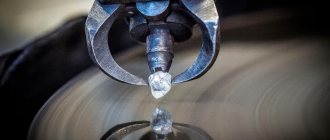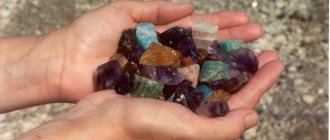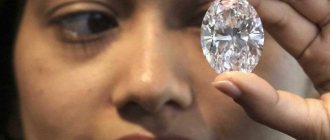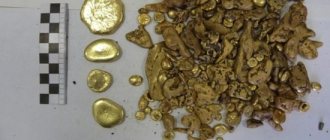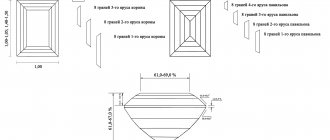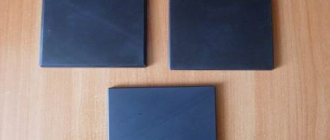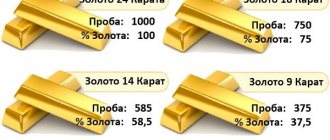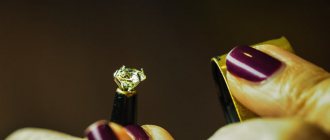The ability to understand precious and semi-precious stones will help you feel more confident when buying jewelry, not succumb to the persuasion of a dubious seller who is trying to pass off an inexpensive stone as a more valuable one, and will allow you to choose a product that is suitable for your zodiac sign. Studying articles on gemology and personal experience will allow you to conduct an initial diagnosis of a pebble in jewelry, even without special devices.
Gemology – the science of precious stones and the quality of jewelry
If you don’t want to buy a piece of glass for the price of a diamond or jewelry stones that are similar in appearance but different in price, spend time studying the most popular stones in jewelry production: emerald, ruby, amber, sapphire, jade and others. A real stone in a product is always a profitable investment , because products decorated with gems do not lose value over the years, only becoming more expensive.
Color and shade
Faceted minerals
It is not so difficult to independently determine which stone is inserted into the jewelry. At the first stage, start from its color and shade: many stones belong to a certain color range. Thus, rubies can only be red, emeralds can only be green, but sapphires are not always only blue; there are also fancy specimens of yellow, garnet, red and even pink-orange or orange.
Many jewelers resort to refining natural crystals and this is completely legal. Having gone through special processing, the gem does not cease to be natural , but acquires a brighter, more vibrant color, and often a unique shade, rarely found in nature. The properties and characteristics of such stones do not change, but the stone becomes visually much more attractive.
Too bright a shade of an inexpensive gem should alert you: in nature, such minerals are extremely rare and cost incredible amounts of money
To immediately understand such nuances, study special tables of minerals, precious and semi-precious stones, examine special sets of samples, take a closer look at jewelry in well-known jewelry boutiques - there the likelihood of running into a fake is minimal, branded companies value their reputation.
Classification by quality
This list of qualities is responsible for the visual beauty and aesthetics of the stone.
Color
It is impossible to determine the type of mineral solely by color. Even minerals of the same type vary significantly in their shades depending on the presence of certain impurities. The average buyer can easily confuse, for example, topaz and sapphire. And only an experienced homologist, using special crystallographic methods, will be able to determine whether a mineral belongs to a certain species. By color there are white, yellow, purple, red, green, black, pink and blue gems.
Transparency
Transparency is a very important property of a gemstone, on which its price largely depends.
Gemologists understand transparency as the ability of a mineral to transmit light through itself. The transmission of light is influenced by the structure of the crystal; as well as the presence in the structure of the mineral of defects or inclusions that distort the flow of light. The degree of light transmission of a certain mineral is determined by a spectrophotometer. According to the degree of transparency, minerals are divided into:
- absolutely transparent - lightly colored or colorless gems, through which objects are clearly seen, without any changes;
- half transparent - colored and colorless stones, through which you can observe objects distorted or blurred;
- minerals that transmit light in thin layers. Light can usually only penetrate the surface layer, but nothing can be seen through the crystal as a whole;
- opaque - do not allow light to pass through.
Shine
Luster refers to the ability of a mineral to refract or reflect light. There are the following types of shine in precious stones:
- Diamond - the reflection of light from the surface is quite strong. Diamonds and zircon, for example, have a diamond-like luster.
- Glassy – reflects light like glass. As an example, we can name, for example, corundum.
- Waxy - slight gloss on a matte surface. Turquoise and jasper have a waxy luster.
- Metallic – strong shine on the surface of opaque minerals. For example, hematite, pyrite.
- Resinous - amber.
- Mother-of-pearl or multi-colored shimmer - pearls, opal.
Hardness
The degree of hardness of gems is determined by the Mohs scale from one to ten maximum points.
As standards, each point corresponds to a specific mineral. The undisputed leaders of the Mohs scale are diamonds - 10, followed by corundum - 9. The hardness of topaz is estimated at 8 points. Topazes are followed in descending order by quartz - 7 points, orthoclase (opal) - 6, apatite - 5, fluorite - 4, calcite - 3, gypsum - 2 and talc - 1. The arrangement of other minerals is determined by their ability to scratch each other's surface. If the material under study scratches the standard, then its hardness is higher than the hardness of the given standard; if not, lower. The harder the mineral, the denser it is, the longer it retains its cut, does not wear off and looks new.
Shine and transparency of the stone
The tables used in jewelry activities have a detailed classification. One of these categories is the transparency and brilliance of stones :
Natural amber with inclusions
- some of the gems simply must be transparent (peridot, green obsidian, zincite);
- opaque sparkling ones include hematites (bloodstone or “glass head”), cobaltine, pyrite, cryptomelane;
- translucent stones (brightly colored, patterned or uniform): rose quartz, chrysoprase, carnelian, chalcedony, opals and semi-opals, onyx, agate, moonstone, some obsidians;
- opaque matte: used with treatment, variscite, turquoise, coral or pearls without treatment.
You can visually assess the transparency and presence/absence of shine of a stone in a piece of jewelry in fairly good lighting. Remember that amber is often valued not for its transparency, but for its foreign inclusions; insects frozen in stone are especially valued.
Stone hardness
Genuine diamond
The last stage of the primary diagnosis is to check the pebble for the hardness characteristic of this group of minerals. Along with the study of other characteristics, in this way you can verify the authenticity or counterfeit of stones.
So, it is enough to run a diamond or diamond across a mirror or glass to make sure that it is natural: even a blow with a hammer will not damage a natural stone, but a synthetic one will crumble into crumbs.
In a store, of course, it is unlikely that anyone will allow you to conduct such experiments: stones in jewelry are valuable for their cutting. has a certificate for each precious stone used in a product , which, in addition to the size, color, purity, sometimes the presence of defects, the cutting method, also indicates the density of the stone. The declared hardness must be characteristic of the group of minerals; the values can be checked in special tables.
Photos of the most beautiful diamonds in the world
Despite their impeccable beauty, diamonds of special quality have a bloody trail through centuries of history. Alas, the legends have only softened over a long time and have survived to this day in a relatively acceptable form. Of course, the 21st century has finally completed the list of terrible crimes associated with diamonds, and today stones are exhibited, sold at auctions and passed on by inheritance without the frightening crime, as was the case historically. But there are also diamonds that are crystal clear before fate and the law; we give three such examples below.
Please note that even the most famous, highest quality diamonds still have inclusions, albeit tiny ones: these defects are the direct, simple and most honest proof of the authenticity of the gemstones.
Diamond Cullinan
– its two aristocratic parts belong to the sweetest lady from Great Britain, or rather the entire English court. And the complete Cullinan family includes 9 large diamonds and about a hundred small ones. The original diamond measured 11 x 5 x 6 cm and weighed more than 600 grams (3106 carats).
| Cullinan I 530 carat | Cullinan II 317 carats |
Excelsior
– held the title of the largest diamond until the birth of Kulinan. The original weight of the Excelsior diamond was 995 carats, and after cutting, 21 beautiful diamonds were seen, and all of them quickly went to private collections and fashionable jewelry houses.
| The largest of the Excelsiors | Heidi Klum, Excelsior advertising | Diamond before cutting |
Centenary
- closes the top three and at the same time is the most mysterious, albeit infinitely beautiful diamond in the world. 274 carats were cut by professionals from De Beers, and the stone owes its origin to the same mine in South Africa where Cullinan was found. Today Centenary is not exhibited and, moreover, it is unknown where this marvelous diamond, insured for a record amount of $100 million, is located.
The cost of such diamonds is incalculable, and it is unlikely that at least one of them will ever be sold again. The price of 2.5 million dollars for one of these stones is very modest, and a diamond presented by Heidi Klum as a swimsuit decoration was sold for $11 million.
In our store, diamonds are presented, of course, not in such a stellar format, but the authenticity and quality of the stones indicated in the characteristics certainly does not raise doubts or questions.
The catalog of diamond products includes various jewelry and accessories; we are sure that here you can find a gift for yourself or a loved one. All diamond products come with an expert opinion, and when purchasing online there is an additional 5% discount.
Artificial or natural?
It can be very difficult to distinguish natural stones from professional fakes on your own, without special equipment. Each mineral has its own authentication test, which includes research into the above and some other characteristics. Even the framing of the gem in the product plays a role: for example, a diamond is set only in gold or platinum, and its lower part remains free, since in the jewelry industry it is believed that this way the stone will shine brighter.
There are a lot of large stones in the world
The authenticity of a diamond is determined in two ways:
- if you look at the stone from the side, the fake will not shine (it retains its shine only in frontal projection), and the natural gem will retain the depth of its shine;
- Printed text cannot be read through a real diamond; cheap cubic zirconia, often passed off as “brilliants,” allows you to read letters without any problems.
For the most part, natural stones do not conduct heat well: when held in the hands they remain cold, while plastic and glass, even of excellent quality, quickly heat up from human heat.
Armed with a magnifying glass or microscope and knowing the characteristics of a certain stone, you can examine a suspicious gem for the presence of a characteristic pattern or, conversely, the absence of gas bubbles and veins. If you have a keen ear and have a reference stone, you can try to distinguish a fake by its sound: the pieces of glass ring thinner and higher.
And avoid massive specimens: large stones are the opposite of everything in the world and are definitely not available for free sale.
Professional appraisers and an instrumental gemological laboratory, of course, will tell you much more about the stone than you can determine for yourself by eye, hearing, or tactile sensations. In the case of synthesized stones, at the highest level of modern technology, even an experienced specialist. In addition to specialized diagnostics, even the possibility of extracting a particular type of mineral in a particular deposit is checked. Such examinations, naturally, take time and are expensive.
Methods for checking diamonds
If you carefully examine the photographic examples, the first and most significant difference between natural stones and artificial ones is their purity. Natural origin will always be distinguished by the presence of any kind of inclusions inside a diamond (and any other stone); small cracks, so-called “curtains” and other defects, without which no natural stone can do, will be noticeable. It is impossible to create such inclusions in synthetic stones; artificial analogues are always transparent and do not have a single defect.
| Diamond | cubic zirconia |
On some natural stones, these nature marks are visible without magnification, but if you intend to purchase a diamond or a finished product with one, arm yourself with a small loupe with 10x magnification. Such a device is quite inexpensive, a few hundred rubles, offered under the name “binocular magnifying glass,” but it will come in handy many times in life, and not only when buying diamonds.
In addition to a magnifying glass, which will instantly reveal the secret of the origin of the stone by magnifying the inclusions in it, you can identify a diamond using... letters. Yes, yes, you will need any printed text on a light background, even a black line will do. Through cubic zirconia you can even see the letters on a business card, but with a diamond you won’t be able to read it. Moissanite has different optical properties and depends on the type and quality of polishing of the girdle - a ghosting effect may be observed.
| What happens if you look through cubic zirconia and diamond at the line |
Another reliable and simple method will help you distinguish a diamond from a moissanite: you will need a bright flashlight, water, a white sheet and a plastic cover. Place water in the lid, stones in the same place, shine a flashlight from above so that the reflection of the diamonds and moissanites transfers to the paper. The reflections from diamonds will resemble the flame of a gas burner on a home stove, and moissanites, being a quarter brighter than diamonds, will show long beams with a wide spectrum of color.
| Diamonds | Moissanites |
And another, popular and effective way to check whether a diamond is in front of you or not is a transparent glass of water.
If you immerse a diamond in water, it will be impossible to see it in the glass. It is not true.
A diamond in water does not reflect, but the edges of the stone themselves are clearly visible. Diamond analogues - cubic zirconia and moissanite - will produce colored highlights at a certain incidence of light.
| Diamond visible in water | |
We can recommend to the most meticulous and principled buyers a simple and inexpensive device, a tester that focuses on the thermal and light radiation of stones. In popular online stores, such devices are sold for a very reasonable price, less than 1000 rubles, and the efficiency of the device is quite enough to identify a diamond or other stone in a second. There is a limitation: no household tester can recognize diamonds larger than a carat.
